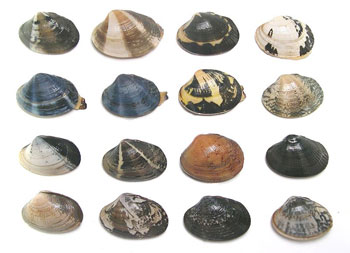Clams Ahoy!
Everything you always wanted to know about Clams but were afraid to ask!!
Manilla Clams
Small Sweet Pacific Clams
Manilla clams, Venerupis Philippinarum, are also known as Japanese littlenecks, Manila Clams, and Japanese Cockles, and are small, Pacific, hard shell clams. They grow up to 3 inches across, and despite their coloring being highly variable as the image below from Wikipedia Commons shows, are easily distinguished by their triangular mottled markings. Their foot when live is orange.
 Many
Manilla clams are imported from Japan, although they are also
farmed in Washington State and British Columbia
(sustainably and with little environmental threat unlike some fish farming).
They are native from China to Southern Siberia, and also now exist in the
wild on the West Coast of the United State from Central California to
British Columbia as they were accidently introduced
in the 1930s with oyster spat (oyster larva) from Japanese oysters. About
1000-1500 tons are harvested yearly from British Columbia farms, 500 tons
from Washington state, and smaller amounts from Oregon and California.
Many
Manilla clams are imported from Japan, although they are also
farmed in Washington State and British Columbia
(sustainably and with little environmental threat unlike some fish farming).
They are native from China to Southern Siberia, and also now exist in the
wild on the West Coast of the United State from Central California to
British Columbia as they were accidently introduced
in the 1930s with oyster spat (oyster larva) from Japanese oysters. About
1000-1500 tons are harvested yearly from British Columbia farms, 500 tons
from Washington state, and smaller amounts from Oregon and California.
They can live up to ten years, but are usually harvested at 3-4 years of age and under 3 inches. Manilla clams live in bays and other estuaries between the low tide and high tide water lines (the intertidal zone) and not very deep below the surface, less than 2 inches. They have two relatively short siphons on the opposite end from their foot that they use to suck in and expel water, hence they do not burrow deep. For this reason they are sometimes called littleneck clams, although they have no relationship to the eastern littleneck, other than both being small tasty hardshell clams. You'll find them in mud, sandy mud, and living between rocks as well. They even like to live in old tires sometimes used as bumpers on docks!
These are hardy little clams, making them ideal for farming and for spreading widely naturally. They tolerate a wide variety of salinities, well under 50% of seawater, and can tolerate a significant level of pollution and still thrive.
Now the fun part, they are sweet and tasty and not only humans like to eat them but also a wide variety of other creatures including raccoons, wild boar, moon snails, crabs, gulls, and many species of fish. Sometimes tiny pea crabs live inside their shells.
I have had them primarily steamed. Unlike the eastern US softshell clam commonly called a steamer (Mya arenaria) which is steamed in ordinary water, Manilla clams are usually steamed in a broth which may include wine, beer, or stock of some type, usually combined with ingredients such as garlic, onions, herbs, black bean sauce and more. Some beef aficionados swear by beer based steaming mixtures and I can report that they work well. I prefer then steamed in beer when drinking beer and steamed in wine when drinking wine.
Manilla clams are also commonly prepared with pasta dishes and usually served whole, in shell. They are also excellent in soups. Chefs like them as they are widely available and relatively cheap; last price seen was under US$5 a pound.
 Hi,
we are Ted and John, just two guys who love Clams and other seafood.
Hi,
we are Ted and John, just two guys who love Clams and other seafood.